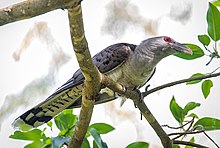| Channel-billed cuckoo | |
|---|---|

| |
| Channel-billed cuckoo in a fig tree | |
| Scientific classification | |
| Domain: | Eukaryota |
| Kingdom: | Animalia |
| Phylum: | Chordata |
| Class: | Aves |
| Order: | Cuculiformes |
| Family: | Cuculidae |
| Genus: | Scythrops Latham, 1790 |
| Species: | S. novaehollandiae
|
| Binomial name | |
| Scythrops novaehollandiae Latham, 1790
| |
| Synonyms[2] | |
|
Scythrops psittaceus Kerr, R. 1792 | |
The channel-billed cuckoo (Scythrops novaehollandiae) is a species of cuckoo in the family Cuculidae. It is monotypic within the genus Scythrops.[3] The species is the largest brood parasite in the world, and the largest cuckoo.[4]
It is found in Australia, New Guinea and Indonesia; additionally, it is vagrant in New Caledonia and New Zealand. The species is migratory over part of its range. There are three subspecies, one migratory, the other two resident. The species is listed as least concern by the IUCN.
- ^ BirdLife International (2016). "Scythrops novaehollandiae". IUCN Red List of Threatened Species. 2016: e.T22684079A93013251. doi:10.2305/IUCN.UK.2016-3.RLTS.T22684079A93013251.en. Retrieved 16 November 2021.
- ^ Australian Biological Resources Study (12 February 2010). "Subspecies Scythrops novaehollandiae novaehollandiae Latham, 1790". Australian Faunal Directory. Canberra, Australian Capital Territory: Department of the Environment, Water, Heritage and the Arts, Australian Government. Retrieved 10 October 2019.
- ^ Payne (2005), p. 380.
- ^ Payne (2005), p. 6.
